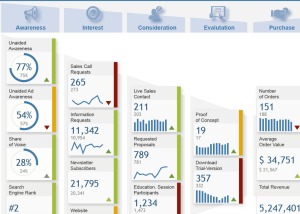 In recent years, corporate brand and marketing teams have pushed their market research departments and agencies to go beyond using PowerPoint presentations to efficiently deliver data and insights. As a result, they’re increasingly turning to online dashboards to create informative stories, observe and act on customer feedback, and analyze trends, all with the goal of inspiring and driving action. But effective online dashboards must be built properly. Below are seven tips to take into consideration to ensure you fully leverage the power of online dashboards.
In recent years, corporate brand and marketing teams have pushed their market research departments and agencies to go beyond using PowerPoint presentations to efficiently deliver data and insights. As a result, they’re increasingly turning to online dashboards to create informative stories, observe and act on customer feedback, and analyze trends, all with the goal of inspiring and driving action. But effective online dashboards must be built properly. Below are seven tips to take into consideration to ensure you fully leverage the power of online dashboards.
1. Plan ahead for how data will be consumed.
It’s crucial to recognize how the data is going to be used. More importantly, understand all of the available data sources and then determine which ones should be included in the dashboard.
2. Use infographics judiciously.
A dashboard full of boring charts is the 21st century version of the 250-page PowerPoint deck. Dashboards that leverage infographics are much more engaging and drive greater usage. Dashboards should not be overflowing with infographics, but there should be a good variety. My personal preference is to have an interactive infographic that immediately communicates key results vs. benchmarks.
3. Use multiple data sources.
Pulling in brand health measures, advertising, sales, satisfaction, new product launches, website traffic, social measures, and weather, etc., is very effective for understanding what is going on with a brand. While the pure researcher may argue that they are not perfectly aligned, it does help the data consumer see everything that is going on. And the reality is that senior management will ask questions about everything that impacts the business anyway.
4. Make the connection between dashboards and company objectives.
The best way to drive usage is to have your dashboard tied directly to company objectives, such as sales, service, and quality. For example, pull in actual sales performance vs. goals and tie this directly to compensation so that salespeople can see their commission payouts based on current status in addition to what is needed for the next level of payout. By making dashboards relevant, you can more easily achieve your objectives.
5. Adapt.
While good planning is key to building a great dashboard, it needs to continuously evolve as businesses change and as data sources improve. Ideally, these changes can be done in-house and in an immediate fashion.
6. Build active dashboards.
With today’s dashboards, we can easily send alerts and require follow up. For example, if a region’s sales performance drops below a certain threshold, that manager should receive an alert with all associated metrics and be required to submit an associated action plan. As you build dashboards at the individual sales rep level, you should also report on the key drivers of business.
7. Leverage big data.
There is so much data available today, that we must improve the way we consume and act on it. Seek out tools that let you interrogate large data sets, and then aim for crisp and clean dashboards to display the results. Doing so will turn unusable data into useful information that can be distributed to relevant parties in your organization for immediate action.
Want to learn more? Get informative articles delivered to your inbox automatically by subscribing to the MarketResearch.com blog.
About the Author
John Bird is vice president of North America for Dapresy, a global provider of data visualization and data integration software.


